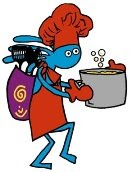Under the Roman Emperor Diocletian, who ruthlessly persecuted Christians, Bishop Nicholas suffered for his faith, was exiled and imprisoned. The prisons were so full of bishops, priests, and deacons, there was no room for the real criminals -- murderers, thieves and robbers. After his release, Nicholas attended the Council of Nicaea in AD 325. He died December 6, AD 343 in Myra and was buried in his cathedral church, where a unique relic, called manna, formed in his grave. This liquid substance, said to have healing powers, fostered the growth of devotion to Nicholas. The anniversary of his death became a day of celebration, St. Nicholas Day, December 6th (December 19 on the Julian Calendar).
Through the centuries many stories and legends have been told of St. Nicholas' life and deeds. These accounts help us understand his extraordinary character and why he is so beloved and revered as protector and helper of those in need.
Waves of European immigrants brought cherished St. Nicholas holiday traditions to the United States. Over time these have melded into some common practices. If one looks closely, these reveal some distinctive characteristics of beloved St. Nicholas.
- Christmas stockings by the fireplace: And the stockings were hung by the chimney with care in hopes that St. Nicholas soon would be there, goes the oft repeated Christmas rhyme. In a story of Nicholas rescuing poor maidens from being sold into slavery, gold dowrey money, tossed in through the window, is said to have landed in stockings left to dry before the fire.
- Orange or tangerine in the toe of filled Christmas stockings: The gold Nicholas threw to provide the dowry money is often shown as gold balls. These are symbolized by oranges or even apples. So the orange in the toe of the stocking is a reminder of Nicholas' gift.
- Candy Canes:These are really candy croziers, one of St. Nicholas' symbols. All bishops carry staffs, hooked at the top like a shepherd's crook, showing they are the shepherds who care for, or tend, their people.
- Gift-giving in secret, during the night: Stockings are filled while children are sleeping. Nicholas did his gift giving secretly, under cover of darkness. He didn't want to be seen and recognized as he wanted those he helped to give thanks to God.
- Seasonal concern for the needy: St. Nicholas gave gifts to those in greatest need—the young and the most vulnerable. Christmas gifts and baskets given to those in need, along with other seasonal contributions to charity, reflect St. Nicholas' unselfish concern for others. He never wanted or expected anything in return.
(Source: St. Nicholas Center where there is more information about the saint, customs from around the world, stories and activities for children, recipes, crafts, and much more to help families, churches and schools learn about and celebrate St. Nicholas.)
Both candy recipes that we've selected this month are used to celebrate the Feast St. Nickolas. We found the recipes at St. Nicholas Center.
SCHOKOLADEKUGELN (German and Austrian Chocolate Balls)
- 1 cup grated MILK CHOCOLATE
- 1 cup SUGAR
- 1 cup ground FILBERTS
- 1 EGG
- 1 tablespoon RUM
- 1 cup COCOA
MARZIPANKARTOFFEL (German Potato Marzipan)
- ¼ pound POTATOES - boiled, grated and chilled
- 1 pound CONFECTIONERS' SUGAR
- 1 pound ALMOND PASTE
Form marzipan into varied fruits, vegetables, flowers, using food coloring to give real appearance. Carrots and potatoes are popular for St. Nicholas Day. Dry 5 minutes in oven at 250º F. Yield, 2 pounds candy.
Both recipes from The Catholic Cook Book: Traditional Feast and Fast Day Recipes by William I. Kaufman. The Citadel Press, 1965.
